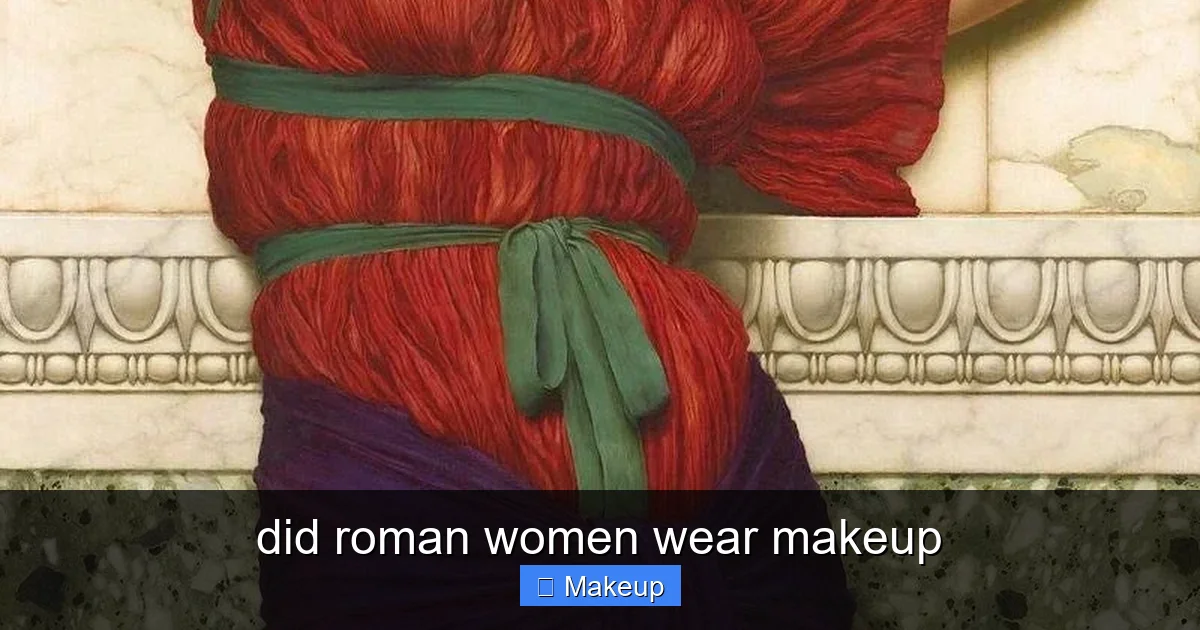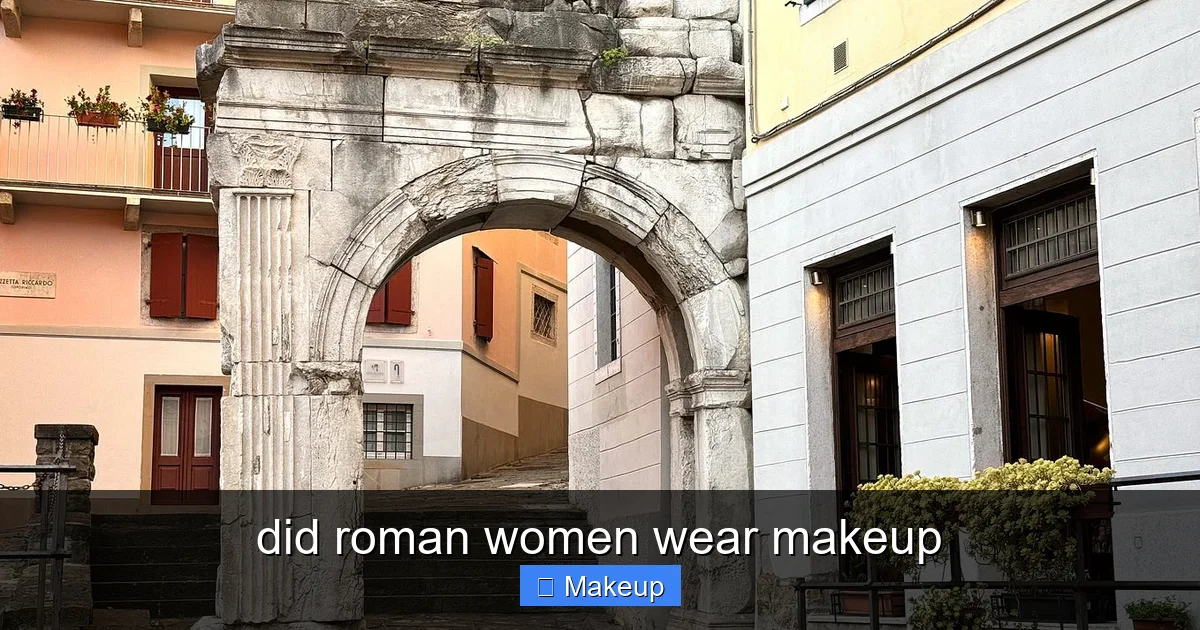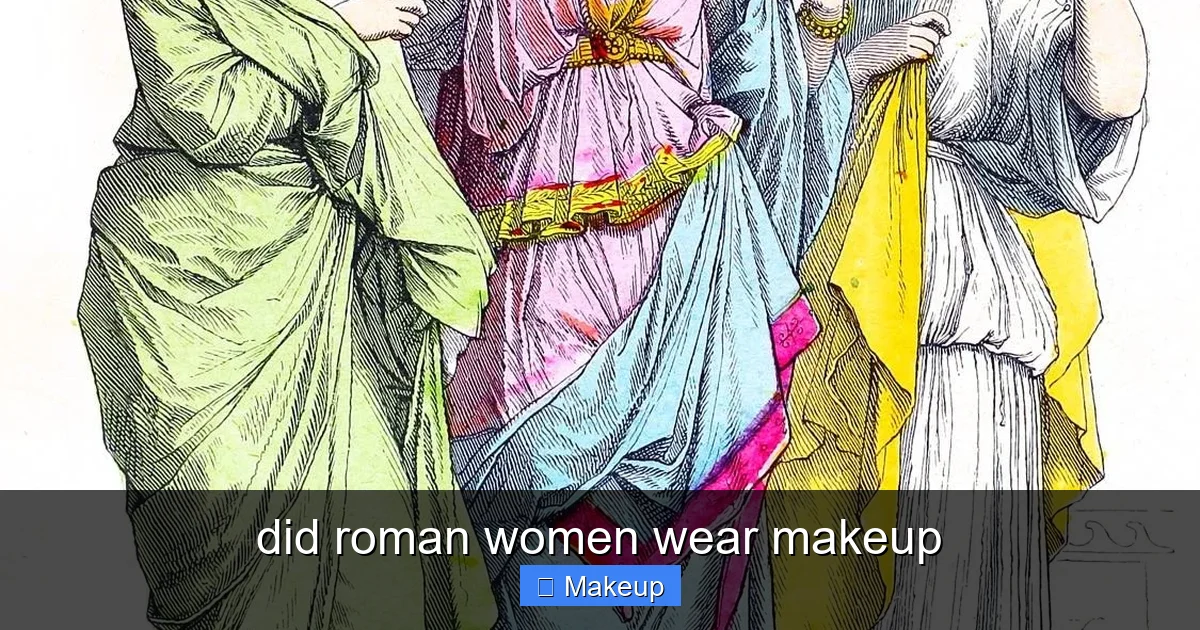
Featured image for this comprehensive guide about did roman women wear makeup
Image source: miro.medium.com
Did Roman Women Wear Makeup? Unveiling Ancient Beauty Secrets
Ever wondered about the beauty routines of women in the ancient world? Specifically, did Roman women embrace the art of cosmetics, much like we do today? The answer is a resounding yes! Far from being a modern invention, makeup played a significant role in the daily lives of women across all social strata in ancient Rome. From enhancing natural features to signaling social status, Roman women’s makeup was a complex blend of beauty, tradition, and practicality.
Join us on a fascinating journey back in time to explore the world of Roman beauty. We’ll uncover the types of products they used, the societal attitudes towards makeup, and how these ancient practices still echo in our modern beauty rituals. Prepare to be surprised by the sophistication and ingenuity of ancient Roman beauty standards!
📋 Table of Contents
The Roman Obsession with a Flawless Complexion
Just like today, a clear, pale complexion was highly coveted in ancient Rome. It was a sign of leisure and a life lived indoors, away from the sun’s harsh rays, thus signifying higher social status. To achieve this desired paleness, Roman women used a variety of concoctions, some surprisingly similar to modern foundations and powders.
Ingredients for a Luminous Look
- White lead (cerussa): This was the primary ingredient for lightening the skin. While effective, it was highly toxic and led to various health issues, including skin damage, paralysis, and even death. Despite the known dangers, its popularity persisted.
- Chalk: A safer, albeit less effective, alternative for those who couldn’t afford or chose to avoid lead.
- Powdered pearls: Used by the extremely wealthy, powdered pearls were mixed with other ingredients to create a shimmering, luxurious finish.
- Barley flour and honey masks: These natural ingredients were used for skin lightening and exfoliation, showing an early understanding of skincare.
These foundation-like substances were often applied thickly, sometimes creating a mask-like effect, especially for public appearances. The goal was to present a perfect, unblemished face, free from the harsh realities of daily life.
| Makeup Category | Common Roman Products | Primary Purpose/Ingredients | Social Context & Prevalence |
|---|---|---|---|
| General Application | Various cosmetics, perfumes, oils | Enhance beauty, signify status, cover imperfections. | Widespread among upper & middle classes; seen as a feminine art, despite some philosophical disapproval. |
| Eye Enhancement | Kohl (antimony, soot), saffron, powdered minerals | Darken eyelids & lashes, create larger, almond-shaped eyes; believed to protect against evil eye. | Highly popular and a staple, applied with slender rods (stili). |
| Complexion Whitening | White lead (cerussa), chalk, rice powder, tin ash | Achieve a pale complexion, a sign of aristocracy and beauty. | Essential for many women, though white lead was known to be toxic and caused skin damage. |
| Lip & Cheek Coloring | Red ochre, plant dyes (e.g., fucus), wine lees, mulberry juice | Add youthful flush to cheeks, subtle color to lips. | Often applied discreetly; vibrant red lips were sometimes associated with prostitutes. |
| Hair & Skincare | Henna, saffron, depilatories, olive oil, honey masks | Change hair color (blonde was popular), remove unwanted hair, moisturize skin. | Extensive routines common for maintaining a desired appearance and combating aging. |
Eyes That Hypnotize: Roman Eye Makeup
Once the canvas of the face was perfected, attention turned to the eyes. Dark, almond-shaped eyes were considered alluring, and Roman women spared no effort in enhancing them. Eye makeup was perhaps the most prominent feature of their beauty routine, with rich pigments used to create dramatic effects.

Learn more about did roman women wear makeup – did roman women wear makeup
Image source: miro.medium.com
Kohl: The Ancient Eyeliner
Kohl, a substance primarily made from antimony or lead sulfide, was universally popular. It was used to darken the eyelashes and eyebrows and to create a defined line around the eyes, much like modern eyeliner. The application method involved a thin stick (often made of ivory, bone, or wood) dipped in kohl and then carefully drawn along the lash line.
Other popular eye makeup ingredients included:
- Soot or ash: Mixed with oil or water to create a dark paste for the eyelids and brows.
- Crocus and saffron: Used to add yellow or orange hues, particularly for eyeshadow.
- Crushed malachite: Provided a vibrant green pigment for the eyelids, adding a touch of exoticism.
Eyebrows were also meticulously groomed. Unibrows were considered attractive, and women would often use false eyebrows made from finely shaved mouse fur or darken their own with kohl to achieve a fuller, more defined look.
Lips and Cheeks: Adding a Flush of Color
Beyond the eyes and complexion, Roman women’s makeup routines also included adding color to the lips and cheeks. A rosy flush was seen as a sign of health and vitality, while colored lips enhanced facial expressions.

Learn more about did roman women wear makeup – did roman women wear makeup
Image source: world4.eu
Rouge and Lipstick: Ancient Blushes and Stains
- Red ochre (minium): A common pigment for both cheeks and lips, providing a deep red hue. It was often mixed with animal fat or beeswax to create a creamy texture.
- Madder root: Another natural source of red dye, used to create lip and cheek stains.
- Mulberries and wine dregs: These natural ingredients were pressed onto the lips and cheeks for a subtle, natural tint.
- Poppy petals and rose petals: Crushed and applied to the cheeks for a delicate flush.
The application of rouge was quite liberal at times, with some sources suggesting women applied so much that it was practically theatrical. However, it’s important to remember that such accounts often came from male satirists who were critical of women’s use of cosmetics.
The Societal Context of Roman Cosmetics
The use of makeup in ancient Rome wasn’t just about aesthetics; it was deeply intertwined with social status, morality, and gender roles. While most women used some form of cosmetic, the extent and quality varied significantly.
Makeup and Social Standing
Wealthier women had access to a wider range of imported and expensive ingredients, as well as personal slaves (cosmetae) who were skilled in applying makeup. These women often used makeup to showcase their status and adherence to societal beauty ideals. For instance, a pale complexion signified that one did not need to work outdoors, a privilege of the elite.
However, there was a delicate balance. Too much makeup could be perceived as artificial, ostentatious, and even associated with prostitutes. Roman moralists, particularly men like Ovid and Juvenal, frequently critiqued what they saw as excessive cosmetic use, viewing it as a sign of deception and a lack of natural beauty.
Despite these criticisms, makeup remained a pervasive practice. It was seen as a necessary tool for women to maintain their beauty, attract a suitable husband, and uphold their family’s honor by presenting a well-groomed appearance.
Ancient Roman Beauty Tools and Regimen Insights
Achieving their desired look required more than just ingredients; it also involved a sophisticated array of tools and a detailed daily regimen. Ancient Roman beauty was a meticulous process.
A Lady’s Vanity Kit: Essential Tools
- Speculum: Polished metal mirrors, often made of bronze or silver.
- Spatulas and applicators: Made from bone, ivory, or wood, used for mixing and applying pigments.
- Pumice stones: For exfoliating skin and hair removal.
- Tweezers (volsellae): For plucking unwanted hair, especially eyebrows.
- Oil lamps: Used to heat waxes for hair removal and to provide light for application.
- Unguentaria: Small glass or alabaster bottles for storing oils, perfumes, and cosmetic pastes.
A typical beauty regimen for a wealthy Roman woman would involve:
- Bathing, often in public bathhouses, followed by oiling and perfuming the body.
- Applying a face mask for cleansing or lightening (often overnight).
- Applying a base of white lead or chalk.
- Defining the eyes with kohl and applying eyeshadow.
- Adding color to cheeks and lips with various pigments.
- Styling hair with elaborate updos, often using heated curling irons.
This demonstrates a comprehensive approach to beauty that extended beyond just makeup application, encompassing skincare, hair styling, and perfumery.
Comparing Ancient and Modern Beauty Practices
While the ingredients and societal norms have evolved, the fundamental desires driving Roman women’s makeup use are strikingly similar to ours today. The pursuit of a flawless complexion, enhanced eyes, and a healthy glow remains universal.
Key Similarities and Differences
- Complexion focus: Both eras emphasize a smooth, even skin tone, though modern standards often lean towards a natural glow rather than extreme paleness.
- Eye enhancement: Eyeliner and eyeshadow remain staples, designed to define and dramatize the eyes.
- Lip and cheek color: Blushes and lipsticks continue to add vibrancy and health to the face.
- Ingredient safety: Modern cosmetics undergo rigorous testing, a stark contrast to the dangerous lead-based products of Rome.
- Social perception: While makeup is largely accepted today, there are still ongoing discussions about “natural beauty” versus cosmetic enhancement, much like in ancient Rome.
- Accessibility: Cosmetics are far more accessible and diverse today, catering to a wider range of skin tones and preferences.
The journey from toxic lead foundations to modern, dermatologically-tested products is a testament to progress, yet the underlying human desire for self-expression and enhancement through beauty remains constant. Understanding Roman women’s beauty secrets offers a fascinating glimpse into the enduring power of makeup across millennia.
🎥 Related Video: Did ancient Egyptians use Lapis Lazuli as #eyeshadow ?
📺 Erin Parsons Makeup
Frequently Asked Questions
Did Roman women wear makeup?
Yes, Roman women certainly wore makeup, though their beauty standards and products differed significantly from today’s. A pale complexion was highly desired, often achieved through various creams and powders.
What kind of makeup did Roman women use?
Roman women used a range of products including kohl for eyes, chalk or white lead for lightening skin, and red ochre or plant dyes for rouge on cheeks and lips. They also applied perfumed oils and hair dyes.
Was wearing makeup common for all Roman women?
While makeup was widely adopted, its extravagance and quality often reflected a woman’s social status. Wealthy Roman women had access to finer, more expensive ingredients and a wider array of cosmetic choices, sometimes even employing enslaved people specifically trained in beauty application.
What were the common ingredients in Roman makeup?
Common ingredients included lead carbonate (white lead) for skin whitening, antimony or soot for darkening eyes, and red ochre, madder root, or even wine dregs for blush. Unfortunately, many of these ingredients, especially lead, were toxic and harmful with prolonged use.
How did Roman women apply their makeup?
They used various tools for application, such as small sticks for kohl, fingers for creams and powders, and sponges for smoothing. Servants often assisted wealthy women, meticulously applying each product to achieve the desired look.
What was the main purpose of makeup for Roman women?
The primary purpose was to enhance beauty according to Roman ideals, which prioritized a fair complexion, rosy cheeks, and defined eyes. Makeup also served as a social marker, indicating wealth, status, and adherence to current fashion trends.
